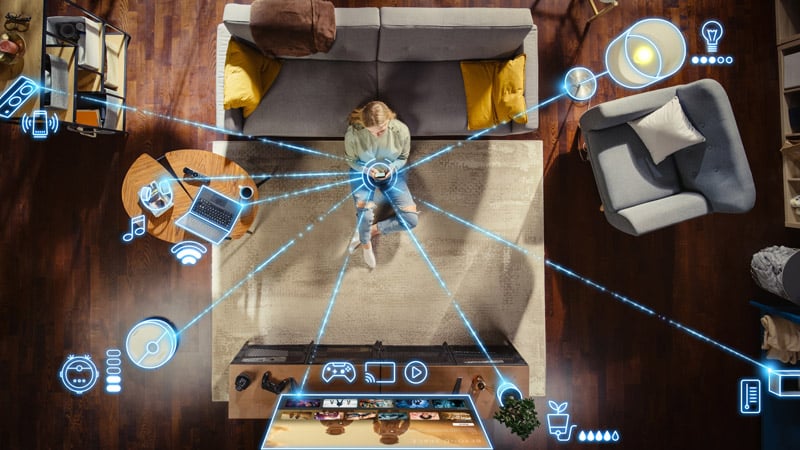
Connecting the device dots: why test automation can achieve greater IoT innovation
- 4 minute read
-
Author: Mobica
The Internet of Things (IoT) is all-pervasive. From smartphones to edge devices in all manner of industries, the connected revolution can be seen everywhere you look.
If you’re looking to release IoT software updates faster, and accelerate development for new platforms, then test automation holds real power.
In this blog, we discuss how you can tap into the efficiencies automated testing tools bring.
The latest data reveals there are approximately 15.14 billion connected IoT devices today - a figure expected to almost double to 29.42 billion by 2030. By anyone's standards, that’s an incredible market opportunity.

With connected devices everywhere you look, automation is increasingly becoming embedded into the very fabric of our day-to-day lives. So, it makes perfect sense to consider how you can unlock greater automation when developing software, too.
While certain companies have embraced some degree of testing automation, increased uptake is needed to deliver IoT innovation faster. In fact, most businesses need to accelerate their uptake of test automation significantly. Research has shown that only 5% of companies carry out fully automated testing, with two-thirds of software development companies conducting the tests in a 75: 25 (manual: automation) ratio, or 50:501.
For those in the connected device market looking to break away from the pack, test automation could help you achieve greater IoT innovation.
Did you know?
85% of development managers saying it’s becoming harder to deliver innovation faster, without compromising on quality and increasing the risk of bugs in production2.
What is test automation?
Automated testing has revolutionised modern software development. Prior to this, tests had to be completed manually. This was not only slower but more liable to errors - not to mention more expensive too.
Test automation uses software to automatically run tests. By automating repetitive and time-consuming tasks, businesses can concentrate on delivering unrivalled customer experiences, while introducing new efficiencies to their operations too.
Automated testing software is efficient, accurate, cost-effective and scalable. It can be reused across multiple project iterations, plus offers greater test coverage, so issues can be addressed quickly.
Crucially, because your developers are getting feedback on the quality of their code more quickly, it lets you deliver IoT innovation faster. It allows you to release new connected device features quicker and more frequently, and is well-suited to large projects or those requiring repeated tests. It’s also a better approach for operational testing, supporting simultaneous users while being capable of managing significant processor and memory loads.
According to IBM, it costs $80 on average to fix defects early in development, compared with $7,600 during production3. With manual testing vulnerable to human error, automated software testing ensures any issues can be identified fast in the software development cycle.
Smartphones, tablets, edge components, cloud services, solution integration for connected devices… All of these can benefit from test automation.

Connected concerns for automation testing
As more and more businesses look to capitalise on the efficiencies that test automation can realise, it’s worth considering specific areas of focus that decision-makers should be considering at this time.
IoT interoperability is a key one. When done properly, IoT interoperability allows different devices, platforms and systems to work together seamlessly. Otherwise, if interoperability with other devices has not been fully developed and tested, users will frequently come across problems.
Looking forward, it’s likely the focus of test automation in this space will shift towards focusing on API and integration testing. This will help ensure connected devices remain stable and usable at all times.
In addition, embedded systems are becoming increasingly vulnerable to cyber threats. Test automation will need to incorporate more security testing methodologies to identify and address potential vulnerabilities in embedded software. This area will be enhanced by AI and machine learning solutions, which can find and resolve any potential security issues fast.
When planning to implement test automation across your projects, it pays to take the time to choose the right testing framework too. This framework will manage the automation process and cover how tests are created, executed and reported on. It brings together guidelines, coding standards, concepts, processes and practices, to enable easy scripting, scalability, modularity and reusability.
Establishing the right framework is an essential step in the test automation journey. As connected device innovations evolve and become increasingly complex from a testing standpoint, it’s important to get the fundamentals right from the start.
A smarter approach to the smart home
Mobica has extensive experience in integrating test automation strategies. Our skillset covers software quality assurance, validation and verification techniques. We place an emphasis on test automation for languages such as Python, Java, and Javascript, as well as test management, test analysis, and manual testing.
One company we’ve helped is a social media leader, which required test automation support for its smart home device. With limited internal resources available, the business lacked engineers with the domain knowledge to implement this strategy.

Supporting the business for over two years, Mobica provided a team of five specialist software engineers to create a flexible approach to automated testing, which established a series of automation scenarios and triggers.
From designing and implementing a trigger and command testing framework which ran voice tests in an acoustic laboratory, to running multi-device tests in parallel - reducing long-running tests from days to hours - we helped the company take a smarter approach to its smart home device.
We even overcame the challenge of difficult-to-automate tests, with a hybrid approach where testing steps ran automatically but the final ‘pass’ or ‘fail’ decision was in the hands of a Mobica QA expert. They would analyse all the data acquired throughout the test execution process, before making a decision. Mobica also implemented false-trigger tests that detected when a voice accidentally triggered the device, such as if the individual was speaking a different language, or checking for voice recognition in a range of varying noise environments.
Achieving test automation success
Test automation can bring a wealth of benefits to software development for connected devices. If you’re looking to embark on your test automation journey, we’ve created the essential how-to guide to get you started.
1 TrueList, ‘Software testing statistics - 2023’, https://truelist.co/blog/software-testing-statistics/
2 Dog Q Blog, ‘Test Automation Statistics for Making the Right Decisions’, https://dogq.io/blog/test-automation-statistics-for-making-the-right-decisions/
3 Keysight, ‘The Top Seven Test Automation Trends Taking Shape in 2023’, https://www.keysight.com/blogs/tech/software-testing/2023/2/2/the-top-seven-test-automation-trends-taking-shape-in-2023